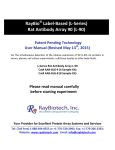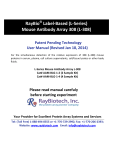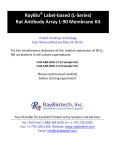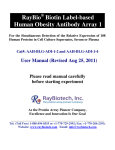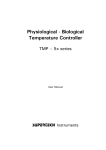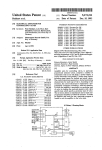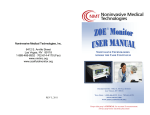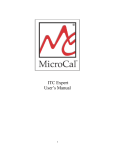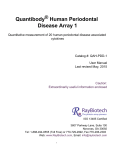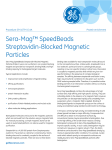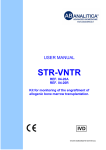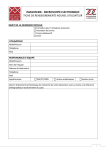Download Manual - RayBiotech, Inc.
Transcript
RayBio Label-based (L-Series) Rat Antibody Array L-90 Membrane Kit Patent Pending Technology User Manual (Revised May 14th, 2015) For the simultaneous detection of the relative expression of 90 (L90) rat proteins in cell culture supernatants. Cat# AAR-BLM-1-2 (2 Sample Kit) Cat# AAR-BLM-1-4 (4 Sample Kit) Please read manual carefully before starting experiment Your Provider for Excellent Protein Array Systems and Services Tel: (Toll Free) 1-888-494-8555 or +1-770-729-2992; Fax: +1-770-206-2393; Website: www.raybiotech.com Email: [email protected] RayBiotech, Inc TABLE OF CONTENTS I. Introduction……..…………………………….......... 2 How It Works………………..………………………… 3 Materials Provided………………………………….. A. Storage Recommendations…………….…… B. Additional Materials Required……………. III. Overview and General Considerations…….. 3 3 5 5 A. Handling Array Membranes…… ………….. 5 B. Incubation of Antibody Array ……………… 5 IV. Protocol……………………………………………………. 6 A. Preparation of Samples……………………..... 7 B. Dialysis of Sample ……………………….…….... 8 C. Biotin-labeling Sample ……………………..... 9 D. Blocking and Incubation…………………….… 11 E. Detection…………………............................. 12 Antibody Array Map…………………………….…… 14 VI. Interpretation of Results………………………….. 16 II. V. VII. Troubleshooting Guide……………………………... 18 VIII. Reference List…...……………………….…............ 19 1 RayBio® L-Series Rat Antibody Array 90 Protocol I. Introduction Recent technological advances by RayBiotech have enabled the largest commercially available antibody array to date. With the RayBio® L-Series Rat Antibody Array 90, researchers can now obtain a broad, panoramic view of cytokine expression. The expression levels of 90 rat proteins can be simultaneously detected, including cytokines, chemokines, adipokine, growth factors, angiogenic factors, proteases, soluble receptors, soluble adhesion molecules and other proteins in cell culture supernatants. The first step in using the Rat L-90 is to biotinylate the primary amine of the proteins in the sample. The membrane arrays are then blocked, similar to a Western blot, and the biotin-labeled sample is added onto the membrane array which is pre-printed with capture antibodies and incubated to allow for interaction of target proteins. After incubation with HRP-Conjugated Streptavidin, the signals can be visualized by chemiluminescence. 2 RayBio® L-Series Rat Antibody Array 90 Protocol II. Materials Provided A. Storage Recommendations Upon receipt, Box 1 should be stored at -20 °C and Box 2 should be stored at 4 °C. The kit must be used within 6 months from the date of shipment. After initial use, Blocking Buffer, Stop Solution, HRP-Conjugated Streptavidin, Detection Buffers C and D should be stored at 4 °C to avoid repeated freeze-thaw cycles (may be stored for up to 3 months, Labeling Reagent, Item B should be fresh preparation before use). The Array Membrane should be kept at 3 RayBio® L-Series Rat Antibody Array 90 Protocol 20 °C and avoid repeated freeze-thaw cycles (may be stored for up to 6 months). Box 1 (store at -20 °C): ITEM B D DESCRIPTION Labeling Reagent Stop Solution E RayBio® L-Series Rat 90 Antibody Array Membranes Blocking Buffer 500X HRP-Conjugated I Streptavidin Concentrate Detection Buffer C K Detection Buffer D L Other Kit Components: F Cat#: AAR-BLM-1-2 Cat#: AAR-BLM-1-4 1 vial 2 vials 1 vial (50 ul) 2 membranes 4 membranes L-90 L-90 1 vial (30 ml) 2 vials (30 ml/ea) 1 vial (100 ul) 2 vials (100 ul/ea) 1 vial (10 ml) 1 vial (10 ml) 1 vial (10 ml) 1 vial (10 ml) Plastic Sheets Box 2 (store at 4 °C): ITEM A G H J N/A M DESCRIPTION Dialysis Vials 20X Wash Buffer 1 Concentrate 20X Wash Buffer 2 Concentrate Spin Columns Plastic Incubation Trays (w/lid) Floating Dialysis Rack Cat#: AAR-BLM-1-2 2 vials 1 vial (30 ml) 1 vial (30 ml) 2 columns 1 tray 1 rack 4 RayBio® L-Series Rat Antibody Array 90 Protocol Cat#: AAR-BLM-1-4 4 vials 1 vial (30 ml) 1 vial (30 ml) 4 columns B. Additional Materials Required 1X PBS, pH=8.0 Shaker 2~5 ml tube 50 ml conical collection tubes Distilled water Kodak X-Omat™ AR film (REF 165 1454) and film processor or Chemiluminescence imaging system large beaker stir plate Eppendorf tube III. Overview and General Considerations A. Handling Array Membranes Always use forceps to handle membranes and grip the membranes by the edges only. Never allow membranes to dry during the experiment. Avoid touching membranes with hands or any sharp tools. B. Incubation Completely cover membranes with sample or buffer during incubation and cover Plastic Incubation Tray with lid to avoid drying. Avoid foaming during incubation steps. Perform all incubation and wash steps under gentle rotation. 5 RayBio® L-Series Rat Antibody Array 90 Protocol Several incubation steps such as step 3 in page 10 (sample incubation) or step 7 in page 11 (HRP-Conjugated Streptavidin incubation) may be done at 4 °C for overnight. IV. Protocol Layout of L-90 Array Membrane 7 cm 7 CM 2.5 cm cm 9 CM 30 columns x 8 rows 30 columns x 36 rows Assay Diagram Assay Diagram 6 RayBio® L-Series Rat Antibody Array 90 Protocol A. Preparation of Samples 1). Seed cells at a density of 1x106 cells in 100 mm tissue culture dishes.* 2) Culture in complete culture medium for ~24–48 hours.** 3) Replenish with serum-free or low-serum medium, such as 0.2% FCS/FBS, and then re-incubate cells for ~48 hours*** 4) Collect the cell culture supernatant and centrifuge at 1,000 g for 10 minutes and store in ≤1 ml aliquots at -80 °C until needed. 5) Measure the total wet weight of the cultured cells in the pellet and/or culture dish. Normalize between arrays by dividing fluorescent signals by total cell mass (i.e., express results as the relative amount of protein expressed/mg total cell mass). Normalization can also be done between arrays by determining the total protein concentration using a total protein assay (RayBiotech recommends the Pierce BCA Protein Assay Kit, cat# 23227). Note: * The density of cells per dish used is dependent on the cell type. More or less cells may be required but should be determined empirically. ** Optimal culture time may be different and depends on cell lines, treatment conditions, and other factors. ***Bovine serum proteins produce detectable signals on the RayBio® L-Series membrane arrays at concentrations as low as 0.2%. When testing serum-containing media, it is 7 RayBio® L-Series Rat Antibody Array 90 Protocol recommended test an uncultured media blank sample for comparison with sample results. B. Dialysis of Sample Note: Samples must be dialyzed prior to biotin-labeling (Steps 5–7). 1. 2. 3. Prepare dialysis buffer (1X PBS) by dissolving 0.6 g KCl, 24 g NaCl, 0.6 g KH2PO4 and 3.45 g Na2HPO4 in 2500 ml de-ionized or distilled water. Adjust to a pH of 8.0 with 1M NaOH and adjust final volume to 3000 ml with de-ionized or distilled water. Load each sample into a separate Dialysis Vials (Item A), 2.53.0 ml of sample per vial for dialyzing. Carefully place all Dialysis Vials into the Floating Rack. Place the Floating Rack into ≥500 ml dialysis buffer in a large beaker. Place beaker on a stir plate and dialyze for at least 3 hours at 4 °C, occasionally gently stirring the dialysis buffer. Then exchange the dialysis buffer with fresh buffer and repeat dialysis for at least 3 hours at 4 °C. Transfer dialyzed samples into a clean eppendorf tube. Centrifuge dialyzed samples for 5 minutes at 10,000 rpm to remove any particulates or precipitates and then transfer and combine each sample into one clean eppendorf tube. Mix well by gently pipetting. Note: The sample volume may change during dialysis. 8 RayBio® L-Series Rat Antibody Array 90 Protocol Note: Dialysis procedure may proceed overnight. C. Biotin-labeling of Sample Avoid contamination with any solution containing amines (i.e., Tris, glycine) as well as azides during the biotinylation process. 4. Immediately before use, prepare 1X Labeling Reagent by briefly centrifuging down the Labeling Reagent vial (Item B) and add 100 µl 1X PBS (pH=8.0) into the vial. Pipette up and down or vortex briefly to dissolve the powder. 5. Add an appropriate amount* of 1X Labeling Reagent into the tube containing the sample and immediately mix the reaction solution. Incubate the reaction solution at room temperature for 30 minutes with gentle shaking. Gently tap the tube to mix the reaction solution every 5 minutes. * Use 7.2 µl of 1X Labeling Reagent for labeling 1 mg of total protein in samples. For example, if sample’s total protein concentration is 0.5 mg/ml you need to add 10.8 µl 1X Labeling Reagent to 3 ml dialyzed sample. Note: The total protein concentration needs to be determined if the sample volume changes after dialysis or if the total protein concentration was determined before the dialysis step. 6. Add 5 µl Stop Solution (Item D) into the reaction solution and 9 RayBio® L-Series Rat Antibody Array 90 Protocol then use the Spin Column (Item J) to remove any unbound biotin. a). Twist off the bottom closure of the Spin Column and loosen the cap (but keep the cap on). Place the Spin Column into a 50 ml conical collection tube. b). Centrifuge the Spin Column at 1,000 g for 3 minutes to remove storage solution. Note: The resin should appear compacted after centrifugation. c). Add 5 ml 1X PBS (pH=8.0) into the Spin Column and centrifuge at 1,000 x g for 3 minutes to remove the 1X PBS. Repeat an additional 2 times to wash the Spin Column. d). Place the Spin Column in a new 50 ml conical collection tube and slowly load 3.5 ml of sample to the center of the compact resin bed. Note: The maximal sample volume is 4 ml for each Spin Column. Do not load over 4 ml of sample into a Spin Column. e). Centrifuge the Spin Column at 1,000 x g for 3 minutes. The sample should filter through the resin and deposit into the 50 ml conical collection tube. Store at -80 0C until needed. Discard the Spin Column after use. 10 RayBio® L-Series Rat Antibody Array 90 Protocol D. Blocking and Incubation 7. Place each membrane printed side up into a Plastic Incubation Tray (provided). 1 membrane per tray. Note: The printed membrane will have a “-” mark in the upper left corner of the membrane. 8. Add 2.5 ml of Blocking Buffer (Item F) to each membrane and cover with the lid. Incubate at room temperature with gentle shaking for 1 hour. 9. Aspirate Blocking Buffer from each tray. Add 2.5 ml of diluted* or undiluted sample onto each membrane and cover with the lid. Incubate at room temperature with gentle shaking for 2 hours. Note: 1). It is recommended to use 2.5 ml of 5-fold diluted biotin-labeled cell culture supernatant. Dilute sample using Blocking Buffer. Note: 2). The concentration of sample used depends on the abundance of proteins. The samples can be concentrated if the overall signals are too weak. If the overall signals are too strong, the sample can be diluted further. Note: 3). Incubation may be done at room temperature with gentle shaking for 2 hours or overnight at 4°C. 11 RayBio® L-Series Rat Antibody Array 90 Protocol 10. Dilute 20X Wash Buffer 1 with deionized or distilled water to prepare the 1X Wash Buffer 1. Aspirate the samples from each tray and then wash by adding 3 ml of 1X Wash Buffer I at room temperature with gentle shaking (5 min per wash). Repeat the wash 2 more times for a total of 3 washes. 11. Aspirate the 1X Wash Buffer 1 from each tray. Dilute 20X Wash Buffer 2 with deionized or distilled water to prepare the 1X Wash Buffer 2. Wash 3 times with 3 ml of 1X Wash Buffer 2 at room temperature with gentle shaking. 12. Aspirate the 1X Wash Buffer 2 from each tray. Dilute the 500X HRP-Conjugated Streptavidin with Blocking Buffer to prepare the 1X HRP-Conjugated Streptavidin. Add 2.5 ml of 1X HRPConjugated Streptavidin to each membrane. Note: Ensure that the vial containing the 500X HRP-Conjugated Streptavidin is mixed well before use, as precipitation can form during storage. 13. Incubate at room temperature with gentle shaking for 2 hours. Note: incubation may be done at 4 0C for overnight. 14. Wash as directed in steps 10 and 11. E. Detection * Do not let the membrane dry out during detection. The 12 RayBio® L-Series Rat Antibody Array 90 Protocol detection process must be completed within 40 minutes without stopping. 15. For detection of 2 membranes, add 2.5 ml of Detection Buffer C and 2.5 ml of Detection buffer D into a tube and mix both solutions. Drain off excess wash buffer. Place membrane antibody side up (“-” symbol is marked in the top left corner of each membrane) on a clean plastic plate or its cover (provided in the kit). Pipette 2 ml of the mixed Detection Buffers on to each membrane and incubate at room temperature for 2 minutes with gentle shaking. Ensure that the detection mixture is evenly covering the membrane without any air bubbles. 16. Gently place the membrane with forceps (antibody side up) on a plastic sheet (provided) and cover the membrane with another plastic sheet. Gently smooth out any air bubbles. Avoid using pressure on the membrane. Work as quickly as possible. 17. The signal can be detected directly from the membrane using a chemiluminescence imaging system or by exposing the array to x-ray film (we recommend using Kodak X-Omat™ AR film) with subsequent development. Expose the membranes for 40 seconds. Then re-expose the film according to the intensity of signals. If the signals are too strong (background too high), reduce exposure time (eg, 5–30 seconds). If the signals are too weak, increase exposure time (eg, 5–20 min or overnight). Or re-incubate membranes overnight with 1X HRP-Conjugated Streptavidin, and repeat detection on the second day. 13 RayBio® L-Series Rat Antibody Array 90 Protocol RayBio® L-Series Rat Antibody Array 90 Protocol 6 91 61 5 8 61 4 91 Blank 3 7 P-1a Blank 2 P-1a 1 1 14 92 92 62 62 Blank Blank P-2a P-2a 2 93 93 63 63 Blank Blank P-3a P-3a 3 94 94 64 64 Blank Blank Blank Blank 4 95 95 65 65 Blank Blank Neg Neg 5 96 96 66 66 Blank Blank Neg Neg 6 97 97 67 67 Blank Blank Blank Blank 7 98 98 68 68 38 38 8 8 8 99 99 69 69 39 39 9 9 9 100 100 70 70 40 40 10 10 10 101 101 71 71 41 41 11 11 11 102 102 72 72 42 42 12 12 12 103 103 73 73 43 43 13 13 13 104 104 74 74 44 44 14 14 14 105 105 75 75 45 45 15 15 15 106 106 76 76 46 46 16 16 16 107 107 77 77 47 47 17 17 17 108 108 78 78 48 48 18 18 18 109 109 79 79 49 49 19 19 19 110 110 80 80 50 50 20 20 20 111 111 81 81 51 51 21 21 21 112 112 82 82 52 52 22 22 22 113 113 83 83 53 53 23 23 23 114 114 84 84 54 54 24 24 24 115 115 85 85 55 55 25 25 25 116 116 86 86 56 56 26 26 26 Blank Blank Blank Blank Blank Blank Blank Blank 27 P-3b P-3b Blank Blank Neg Neg Blank Blank 28 RayBio® Biotin Label-based Rat Antibody Array 1 Map 29 P-2b P-2b Blank Blank Neg Neg Blank Blank 30 P-1b P-1b Blank Blank Neg Neg Blank Blank 18. Save membranes at –20 °C to –80 °C for future reference. V. Antibody Array Map RayBio® L-Series Rat Antibody Array 90 Maps – if needed, larger versions of these maps can obtained by contacting technical support at 770-729-2992 or [email protected]. RayBio® L-Series Rat Antibody Array 90 (L-90) List 15 RayBio® L-Series Rat Antibody Array 90 Protocol VI. Interpretation of Results The following images show the RayBio® L-Series Rat Antibody Array 90 captured using a chemiluminescence imaging system (UVP BioImaging Systems). To obtain optimal results, it is suggested to try several different exposure times until the best one is determined. Then, by comparing the signal intensities, relative expression levels of the target proteins can be made. The intensities of signals can be quantified by densitometry. Anti-HRP (P-1a, P-2a, P-3a) and anti-streptavidin (P-1b, P-2b, P-3b) will produce positive control signals, which can be used to identify the orientation and help normalize the results from different arrays being compared. Antibody affinity to its target varies significantly between antibodies. The intensity detected on the array with each antibody depends on this affinity; therefore, signal intensity comparison can be performed only within the same antibody/antigen system and not between different antibodies. The RayBio® Analysis Tool is a program specifically designed for analysis of RayBio® L-Series Rat Antibody Antibody Arrays. This tool will not only assist in compiling and organizing your data, but also reduces your calculations to a “copy and paste.” Call RayBiotech, Inc. at 770-729-2992 for ordering information. 16 RayBio® L-Series Rat Antibody Array 90 Protocol L-90 Membrane Image 17 RayBio® L-Series Rat Antibody Array 90 Protocol VII. Troubleshooting Guide Problem Cause Recommendation Weak signal or no 1. Taking too much time signal for detection. 2. Film developer does not work properly. 3. Did not mix HRPstreptavidin well before use. 4. Sample is too dilute. 5. Other. 1. The whole detection process must be completed in 30 min. 2. Fix film developer. 3. Mix tube containing HRP-Conjugate Streptavidin well before use since precipitates may form during storage. 4. Increase sample concentration 1.Check if there were any contamination with any solution containing amines in biotin-labeling step Tris, glycine)increase as well as azides during the biotinylation 2. Slightly HRP concentrations. process cot 3. Work as quickly as possible after mix Detection Buffer C and D . 4. Expose film for overnight to detect weak signal. Uneven signal 1. Bubbles formed during incubation. 2. Membranes were not completely covered by solution. High background 1. Exposure time is too long. 2. Membranes dry out during experiment. 3. Sample is too concentrated. 1. Remove bubbles during incubation. 2. Completely cover membranes with solution. 1. Decrease exposure time. 2. Completely cover membranes with solution during experiment. Cover tray w/ lid 3. Dilute sample. 18 RayBio® L-Series Rat Antibody Array 90 Protocol VIII. Reference List 1. Christina Scheel et all. Paracrine and Autocrine Signals Induce and Maintain Mesenchymal and Stem Cell States in the Breast. Cell. 2011;145, 926–940 2. Lin Y, Huang R, Chen L, et al. Profiling of cytokine expression by biotin-labeled-based protein arrays. Proteomics. 2003, 3: 1750–1757. 3. Huang R, Jiang W, Yang J, et al. A Biotin Label-based Antibody Array for High-content Profiling of Protein Expression. Cancer Genomics Proteomics. 2010; 7(3):129– 141. 4. Liu T, Xue R, Dong L, et al. Rapid determination of serological cytokine biomarkers for hepatitis B–virus-related hepatocellulare carcinoma using antibody arrays. Acta Biochim Biophys Sin. 2011; 43(1):45–51. 5. Cui J, Chen Y, Chou W-C, et al. An integrated transcriptomic and computational analysis for biomarker identification in gastric cancer. Nucl Acids Res. 2011; 39(4):1197–1207. 6. Jun Zhong et all. Temporal Profiling of the Secretome during Adipogenesis in Humans. Journal of Proteome Research. 2010, 9, 5228–5238 7. Chowdury UR, Madden BJ, Charlesworth MC, Fautsch MP. 19 RayBio® L-Series Rat Antibody Array 90 Protocol Proteomic Analysis of Human Aqueous Humor. Invest Ophthalmol Visual Sci. 2010; 51(10):4921–4931. 8. Wei Y, Cui C, Lainscak M, et al. Type-specific dysregulation of matrix metalloproteinases and their tissue inhibitors in endstage heart failure patients: relationshp between MMP-10 and LV remodeling. J Cell Mol Med. 2011; 15(4):773–782. 9. Kuranda K, Berthon C, Lepêtre F, et al. Expression of CD34 in hematopoietic cancer cell lines reflects tightly regulated stem/progenitor-like state. J Cell Biochem. 2011; 112(5):1277– 1285. 10. Toh HC, Wang W-W, Chia WK, et al. Clinical Benefit of Allogenic Melanoma Cell Lysate-Pulsed Autologous Dendritic Cell Vaccine in MAGE-Positive Colorectal Cancer Patients. Clin Chem Res. 2009; 15:7726–7736. 11. Zhen Hou. Cytokine array analysis of peritoneal fluid between women with endometriosis of different stages and those without endometriosi Biomarkers. 2009;14(8): 604-618. 12. Yao Liang Tang,et al. Hypoxic Preconditioning Enhances the Benefit of Cardiac Progenitor Cell Therapy for Treatment of Myocardial Infarction by Inducing CXCR4. Circ Res. 2009;109:197723 20 RayBio® L-Series Rat Antibody Array 90 Protocol RayBio® is the trademark of RayBiotech, Inc. This product is intended for research only and is not to be used for clinical diagnosis. These products may not be resold, modified for resale, or used for manufacture of commercial products without express written approval by RayBiotech, Inc. Under no circumstances shall RayBiotech be liable for any damages arising out of the use of the materials. Products are guaranteed for six months from the date of shipment when handled and stored properly. In the event of any defect in quality or merchantability, RayBiotech’s liability to buyer for any claim relating to products shall be limited to replacement or refund of the purchase price. This product is for research use only. ©2004 RayBiotech, Inc. 21 RayBio® L-Series Rat Antibody Array 90 Protocol






















